Shopify vs Etsy: Which One Is Better for Beginners in 2025?

In 2025, over 2.14 billion people will be shopping online, which is more than a quarter of the world’s population.
Whether you’re a hobbyist turning passion into profit or an aspiring entrepreneur ready to go all in, there’s never been a better time to start your eCommerce journey.
But when comparing where to sell online, one of the most common questions is: “eBay vs Shopify, or should I consider Etsy?”
But before you start selling, there’s one big question to answer:
Should you create your own online store or join an existing marketplace?
For most beginners, this decision often comes down to two popular platforms: Shopify and Etsy.
Many new sellers also compare selling on Shopify vs Etsy, especially when deciding where to sell handmade items or digital products.
Both offer ways to reach customers and grow a business, but they work in very different ways.
In this post, we will break down the key differences between Shopify and Etsy to help you choose the right platform, focusing on what truly matters when you are just starting out.
We’ll also cover the pros and cons of Etsy vs Shopify, which is better for artists, and address common questions like “Can I sell on Etsy and Shopify at the same time?”
Let’s start with the basics so you can understand what each platform does best.
Shopify Vs. Etsy — Platforms at a Glance
From physical goods and digital downloads to services and subscriptions, Shopify gives you full control over what you sell and how you sell it.
It’s also known for offering some of the best apps to sell handmade items, making it a top choice for creative entrepreneurs.
While Shopify allows you to build your store from the ground up, Etsy offers a different approach, which is a marketplace designed specifically for handmade, vintage, and craft items.
For many, Etsy is the best online marketplace for artists and crafters looking to reach a global audience.
Before we get into the detailed comparisons, let’s look at what Shopify and Etsy are all about.
What is Shopify?
Shopify is one of the most popular eCommerce platforms in the world. As of 2025, it powers over 5.23 million stores and has helped merchants generate more than $235.9 billion in total sales.
It’s designed to make online selling simple, even if you have zero technical skills. You can launch your store without touching a line of code, thanks to easy drag-and-drop design tools and hundreds of pre-built templates.
From physical goods and digital downloads to services and subscriptions, Shopify gives you full control over what you sell and how you sell it.
Selling handmade items on Shopify is straightforward, and the platform is also popular for digital products.
Everything is built-in:
✅ Hosting
✅ Secure payments
✅ Inventory management
✅ Shipping integrations
✅ Marketing tools
…all in one place, so you can focus on growing your brand, not juggling tech.
What is Etsy?
While Shopify allows you to build your store from the ground up, Etsy offers a different approach, which is a marketplace designed specifically for handmade, vintage, and craft items.
With over 7.5 million active sellers and an estimated $18 billion in goods sold in 2025, Etsy has become the go-to platform for creators and small businesses looking to tap into a niche market.
Etsy is often considered the best online handmade marketplace for beginners and artists.
Unlike Shopify, which requires you to create and maintain a custom-built website, Etsy offers a built-in audience and handles many of the complexities of eCommerce, such as hosting, payment processing, and traffic generation.
Sellers set up individual storefronts within Etsy’s larger marketplace, which can help them reach millions of customers interested in unique, creative products.
Shopify vs Etsy: Quick Comparison
Now that you know the core purpose of each platform, here’s a quick side-by-side comparison to show how they stack up across key areas.
| Feature | Shopify | Etsy |
| Best For | Building a long-term brand with full control | Beginners testing ideas or selling handmade, vintage, or craft items |
| Fees | Monthly subscription + optional app costs | Listing fees ($0.20), transaction fees (6.5%), Ad fees. |
| Scalability | Ideal for small to enterprise-level businesses | Not ideal for scaling beyond a hobby or side income |
| Ease of Use | Takes some learning, but it is beginner-friendly | Easy to use |
| Store Customization | Not Restricted | Restricted |
| Marketing Tools | Advanced tools | Basic tools |
| AI Tools | AI assistant helps you set up your store, get product ideas, and track what’s working | AI helps buyers find products but doesn’t assist sellers much |
| Risk of Platform Changes | Full ownership of your site | Etsy can change rules and suspend shops without warning |
| Reach | Reach via your own channels | Global exposure through Etsy’s network |
| Audience | Requires acquiring an audience | Has a built-in audience |
This table gives a bird’s-eye view of where each platform shines and where it might fall short depending on your needs.
If you’re an artist or just starting out, you’ll find that the Etsy vs Shopify for artists and Etsy vs Shopify for beginners comparisons are especially relevant here.
Now, let’s break down these key differences one by one to help you decide which platform fits your business vision best.
What Is the Main Difference Between Shopify and Etsy?
Now that you have an overview of these platforms, let’s break things down in more detail.
While both platforms let you sell online, they offer very different experiences when it comes to setup, customization, costs, and how much control you have over your business.
Many sellers ask: “Is Shopify better than Etsy for building a brand, or is Etsy better for beginners and artists?”
Let’s understand the difference between Etsy and Shopify across the areas that matter most by covering important aspects, varying from ease of setup to scalability, so that you can confidently decide on the platform that matches your goals.
1. Ease of Setup & Management
When you’re just getting started, simplicity matters. A platform that’s easy to set up can help you go from idea to first sale much faster.
Every online seller, especially those just starting, needs an ecommerce platform that is easy to set up and manage without a hard learning curve.
Let’s see how Etsy and Shopify compete when it comes to user-friendliness and getting started.
Etsy is designed for simplicity. It’s one of the quickest platforms to start selling, and for that, all you need is an account, a product to sell, and a few minutes to complete your first listing.
The platform handles most of the technical aspects, so sellers can focus purely on their products and listings.
The seller dashboard is clean and minimal, with easy navigation to areas like Listings, Orders, and Shop Settings.
Etsy also provides tips to guide new users on each step along the way, such as improving listings and the shop setup process, offering valuable support for building a successful shop.
However, Etsy offers much less control over how your shop looks and functions, which makes it less suitable for users who want to customize the buyer experience or who want to present their store uniquely.
Shopify, on the other hand, is known for its easy-to-use interface, which is perfect for beginners who want to build a professional store without coding skills.
Once you sign up and choose a plan, Shopify walks you through the entire setup process — from naming your store to adding your first product.
The dashboard is clean and well-organized, with clear tabs for Orders, Products, Analytics, and Marketing.
Shopify also offers helpful prompts throughout the homepage, such as setting up shipping rates or adding a domain.
These tips help new store owners stay on track without feeling daunted.
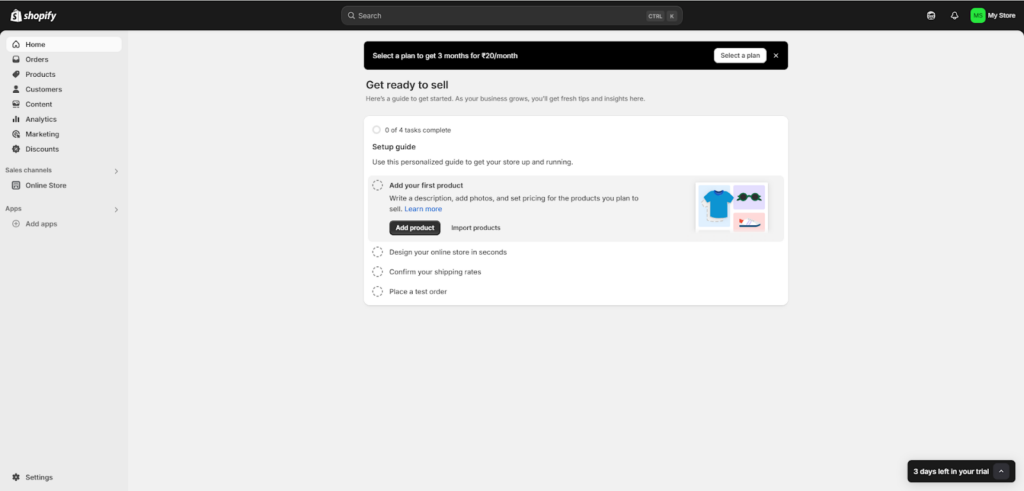
So, even with little or no technical knowledge, anyone can customize a store using drag-and-drop themes and the built-in theme editor.
Shopify also provides built-in educational resources and step-by-step setup guides within the dashboard, covering topics like store policies and international expansion to help streamline the store creation process and make the selling journey much smoother.
So yes, Etsy is the more beginner-friendly platform overall, but Shopify can be an ideal choice, especially if you are looking to build a fully customizable store.
2. Cost-effectiveness
Once you’re set up, the next big consideration is your budget and how pricing models impact your profit over time.
Let’s see how both Shopify and Etsy stack up when it comes to affordability and long-term value.
When starting an online store, cost plays a big role—not just in the initial setup, but also in how fees accumulate as your business grows. Let’s explore how Shopify and Etsy stack up in terms of affordability and long-term value through a pricing comparison.
Talking about Etsy’s pricing model is appealing to new sellers because there’s no monthly subscription to get started.
Instead, you pay a small fee to list each product and then additional fees once you make a sale, which makes it relatively low-risk for those just getting started or testing product ideas.
If you’re wondering “how much does it cost to sell digital downloads on Etsy?”, the answer is: $0.20 per listing, 6.5% transaction fee, plus payment processing and optional ad fees.
Here’s what you’ll pay:
- $0.20 listing fee per item (renewed every 4 months)
- 6.5% transaction fee on the item price, including shipping and gift wrapping
- Payment processing fees (around 3% + $0.25 per transaction, depending on your country)
- 12%–15% Offsite Ads fee if Etsy drives a sale through external advertising
- 2.5% currency conversion fee if your shop’s currency differs from your bank’s
- Regulatory operating fees and VAT on fees may apply depending on your location
Optional Etsy Ads and Offsite Ads, which can incur additional fees from your earnings
This model works well for smaller shops or hobby sellers. But as you grow, these stacking percentage-based fees can cut into your profits, especially when multiple fees are applied per order.
Shopify, on the other hand, offers a subscription-based pricing model, starting at $39/month for the Basic plan. There are no listing fees, so you can add unlimited products without worrying about extra charges.
Here’s what’s included:
- Access to a customizable online store
- Unlimited products and file storage
- Built-in tools for discounts, marketing, and abandoned cart recovery
Shopify also charges transaction fees (2% on the Basic plan), but you can eliminate those by using Shopify Payments, their payment processor.
For growing businesses or high-volume sellers, Shopify’s flat-rate pricing can be more cost-effective in the long run.
For example, while Etsy charges a 6.5% transaction fee on every sale, Shopify doesn’t take a cut per item sold. So if you’re making $5,000 a month in sales, you could save over $300 monthly just on fees.
From a pricing perspective, Shopify offers a more straightforward and scalable structure, making it easier to plan your business expenses. Unlike Etsy, which may seem cheaper initially, its stacked fees can add up quickly as your sales grow.
If you’re comparing Shopify vs Etsy fees in 2024 or 2025, keep in mind that Shopify’s costs are more predictable, while Etsy’s fees can add up fast as you scale.
Think of it like this:
| Stage | Etsy | Shopify |
| Month 1 | ✅ Lower upfront cost | ❌ Monthly fee |
| Month 6 | ❌ Cumulative fees eat into profit | ✅ Predictable cost |
| Month 12+ | ❌ Platform fees limit profit potential | ✅ Better margins, full control |
3. Design & Branding Control
Pricing is important, but how your store looks and feels to customers also plays a huge role in your success.
Now, let’s talk about design flexibility and branding control, and which platform gives you more room to make your store uniquely yours.
Being able to control how your store looks and feels is key to building a memorable brand.
Let’s see how much freedom Shopify and Etsy give you when it comes to customizing your storefront.
When it comes to customizing a shop’s appearance, Etsy offers very limited options.
You can upload a logo, add a banner, and write a short shop description, but the overall layout, fonts, and structure are controlled by Etsy.
As a result of this, all shops on the platform have the same template, which means there is little or no option that can make your store look different from others.
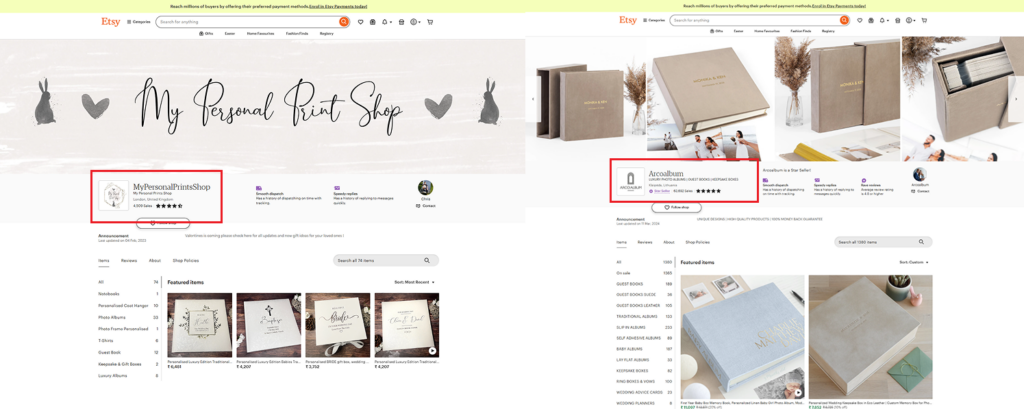
Etsy’s own branding remains prominent throughout the shopping experience, and you can’t remove or modify it.
This restricts you from building a unique brand identity or standing out visually within the platform.
In contrast, Shopify offers complete design flexibility. You can choose from a wide range of themes and customize every element of your store, including colors, fonts, page layouts, and navigation.
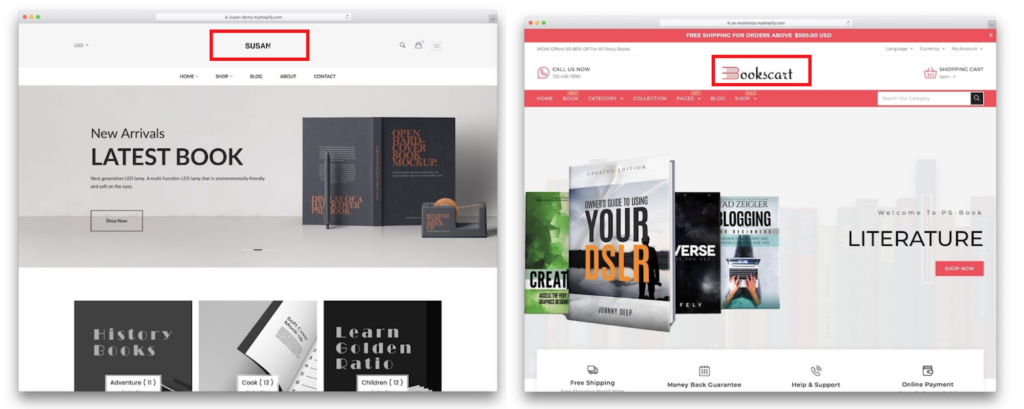
Shopify’s built-in theme editor is easy to use, even for beginners. And if you need more advanced options, you can customize your store using HTML, CSS, and Liquid.
You can also use your own domain name and remove all third-party branding, allowing you to create a fully branded and professional storefront.
While Etsy keeps things simple with limited design options, Shopify gives you the tools to build a unique brand experience from scratch.
Thus, when it comes to design and branding control, Shopify takes the lead.
4. Customization Flexibility
Of course, branding goes beyond appearances — it’s also about how your store works.
So, next, let’s look at how much freedom each platform gives you to customize the functionality of your shop.
Beyond just the visual design, customization is about how much control you have over the features and functionality of your online store.
So when it comes to flexibility, Etsy allows some personalization, but you’re restricted to working within the framework of their marketplace.
For example, you can customize your shop banner, logo, announcement section, shop policies, and feature specific listings or product sections, along with the option to offer personalized or custom items to buyers.
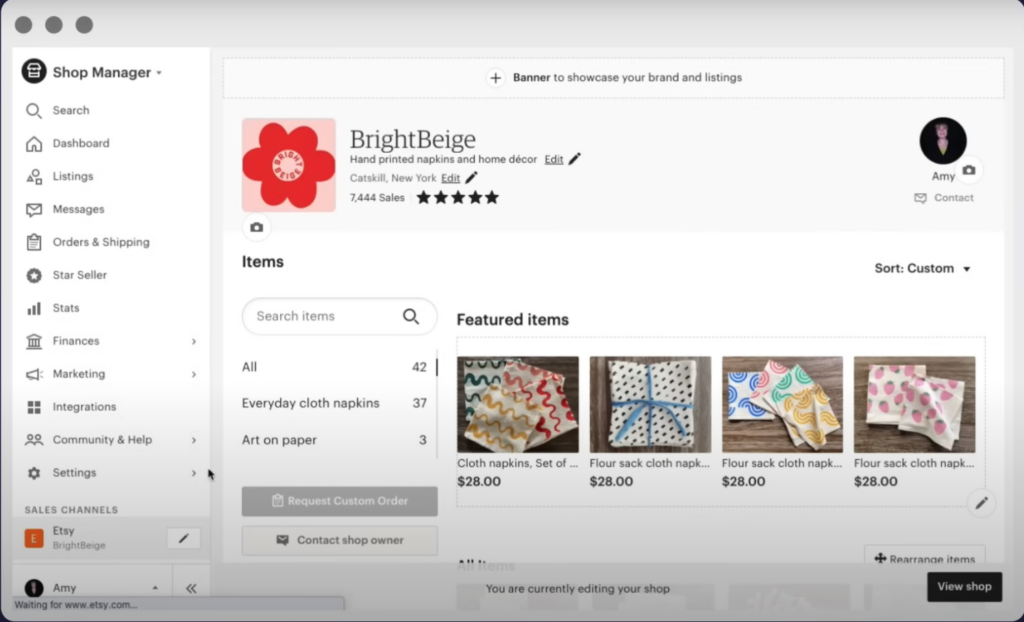
However, beyond these surface-level changes, there’s little room for functional or design flexibility. You can’t modify the layout, add custom pages, or integrate apps to enhance how your shop works.
This makes Etsy simple and consistent, but restrictive if you want to stand out with a fully custom experience.
Shopify, on the other hand, provides comprehensive tools to tailor both the design and functionality of your online store.
You can choose from a wide array of themes and use the built-in customization features in the theme editor to adjust layouts, colors, and fonts, ensuring your store aligns with your brand identity.
For those with coding expertise, Shopify enables direct edits to HTML, CSS, and Liquid files, facilitating deeper customization.
Beyond design, Shopify’s flexible architecture allows for the extension of store capabilities through features like metafields and metaobjects.
Metafields enable the addition of custom data across various parts of your store, such as products and orders, while metaobjects allow for the creation of bespoke data models.
Additionally, the Shopify App Store offers thousands of apps to enhance your store’s functionality, including features like upselling, live chat support, and customer reviews.
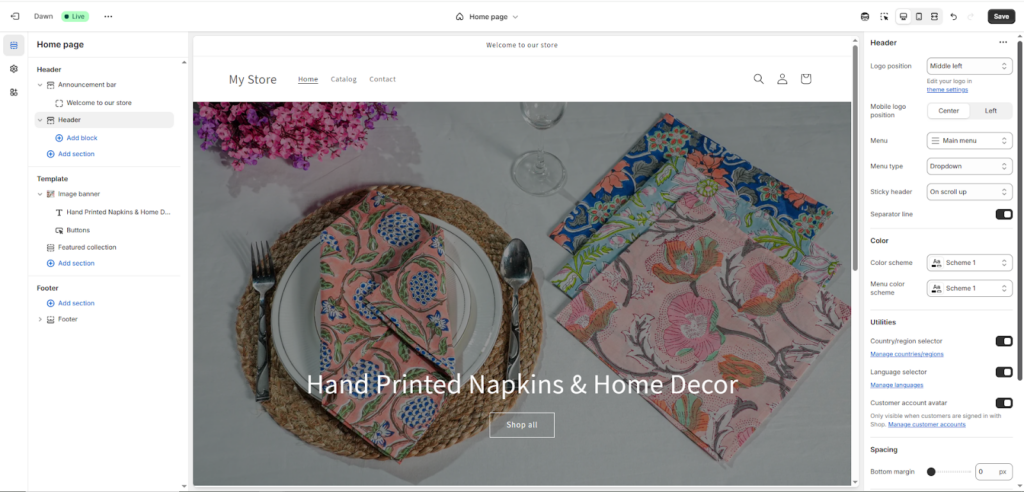
Considering all these aspects, it is clear that Shopify is more flexible. It offers extensive tools and options to tailor your store’s design and functionality, while Etsy confines you to its standardized marketplace structure.
5. Scalability
As your business grows, your platform needs to grow with you.
Let’s explore how Etsy and Shopify handle scalability, whether you are running a hobby shop or planning to build a well-established brand.
Scalability is key, and a good eCommerce platform should support your growth, whether you’re selling a handful of products or building a large-scale brand with thousands of orders.
In that context, Etsy is a great starting point. It offers quick access to a large audience and requires minimal setup, especially if you’re selling handmade or unique products.
But once your sales start increasing, Etsy’s limitations become more noticeable.
Because you are operating within a shared marketplace, you have limited control over your brand’s appearance and how customers interact with your shop. Etsy’s transaction fees start to impact profitability.
On the contrary, Shopify is better suited for businesses with big plans.
Whether you are starting small or aiming to become the next big brand, Shopify grows with you. You can begin with a basic plan and upgrade as your needs change.
The platform supports everything from small product catalogs to thousands of SKUs, all while maintaining performance.
With access to powerful inventory systems, automation apps, international selling features, and advanced marketing tools, Shopify gives you everything you need to scale efficiently.
Plus, you own your customer data, which gives you more control over how you grow your business and who you reach.
Thus, when it comes to scalability, Shopify takes the lead. It offers advanced tools like Shopify Plus for enterprise-level businesses, integrations with third-party apps, and powerful inventory management systems. Its subscription model ensures predictable costs as your business grows.
While Etsy provides a built-in audience, its fee structure and lack of customization make it less suitable for scaling beyond hobby-level selling.
So, if you’re starting small, Etsy is a good option. But if you want to grow your business in the long run, Shopify is the better choice.
Ready to scale your business? Explore our Shopify Plus Development Services to take your store to the next level!
Shopify vs Etsy for Digital Products & Artists
If you’re an artist or digital creator, deciding between Etsy vs Shopify for digital products is a key consideration in 2025.
Etsy is widely recognized as the best online handmade marketplace for beginners and artists, thanks to its built-in audience and ease of use.
However, Shopify is quickly gaining popularity among digital sellers and artists who want more control, advanced branding options, and the ability to scale their business.
One major difference between Etsy and Shopify is that Shopify does not charge listing fees for digital products, making it more attractive for creators who want to sell a wide variety of downloads or scale up their offerings.
If you want to build a personal brand and have full creative control over your storefront, Shopify is often considered the better choice for artists and digital creators.
On the other hand, Etsy gives you instant access to millions of buyers looking for art and handmade goods, which can be ideal for those just starting out or testing new products.
If you’re comparing Pattern vs Shopify, remember that Pattern (Etsy’s website builder) is simple and integrates with your Etsy shop, but offers far less customization than Shopify.
Pattern is best for sellers who want a basic website with minimal setup, while Shopify is designed for those who need advanced features and complete branding control.
6. Sales & Marketing Tools
Growth doesn’t happen without visibility.
You need tools to attract visitors and turn them into buyers, especially if you want your store to grow in the long run.
Having great products is just one part of running an online store — getting people to see and buy them is where sales and marketing tools come in.
Let’s start with Etsy.
Etsy gives you a few basic tools to help promote your products:
- Shop stats and analytics to track views and sales
- Coupons and sales to attract buyers
- Etsy Ads to promote listings within the Etsy marketplace
- Offsite Ads, where Etsy advertises your products on places like Google and social media (but charges extra fees if those ads lead to a sale)
These tools are helpful, especially if you are just getting started and want to take advantage of Etsy’s built-in audience.
By bringing in shoppers who are already browsing for handmade, vintage, or unique items, so you don’t have to worry about driving traffic from scratch.
However, your marketing freedom is limited:
- You can’t create email marketing campaigns to follow up with customers
- There’s no retargeting to bring back visitors who didn’t buy
- You can’t segment your audience or build customer journeys
- You are subject to Etsy’s rules, fees, and ad systems
So, while Etsy helps with visibility in the early days, it becomes harder to grow independently as your business matures.
Shopify, on the other hand, is built for sellers who want full control over their marketing, even if they are just starting.
Out of the box, it offers:
- Email marketing tools to promote new products and send newsletters
- Discount codes and automatic promotions
- Abandoned cart recovery to bring shoppers back
- Sales channel and social media Integrations
And if you want to take things further, Shopify’s App Store gives you access to thousands of third-party tools for SEO, loyalty programs, upsells, SMS marketing, and beyond.
In 2025, Shopify also introduced Shopify Magic and Sidekick AI, like smart assistants that help you write product descriptions, suggest marketing actions, and make data-driven decisions, even if you don’t have a team or marketing experience.
This level of control enables you to build lasting customer relationships and cultivate brand loyalty, ultimately driving long-term business growth.
Thus, when it comes to marketing and growth potential, Shopify clearly has the upper hand. It gives you the tools to grow your way — whether you want to keep it simple or scale like a pro.
7. Customer Relationship Management
Finally, let’s talk about what happens after the sale — and how much control you have over your customer relationships.
Because making one sale is great…
But turning buyers into repeat customers is where sustainable success happens.
As your business grows, success isn’t just about making that first sale — it’s about building trust, encouraging repeat purchases, and staying top-of-mind with your customers.
And the way each platform handles customer relationships plays a big role in how effectively you can do that.
Etsy simplifies customer communication by keeping everything within its own platform. You can message buyers about their orders, like shipping updates, customizations, or questions, but that’s pretty much where it ends.
You don’t really own those customers. Because you can’t grab their email addresses or create a list to reach out to them later. Etsy keeps all that info.
So, if a customer loves your product, they might remember Etsy more than your brand.
Thus, it’s ideal for quick sales but not ideal for building long-term relationships.
On the other hand, Shopify puts you in the driver’s seat. You collect customer information, create email lists, and build automated follow-ups — all under your own brand.
Whether it’s a thank-you email, a discount for repeat buyers, or a loyalty program, you have the tools to stay in touch and build meaningful customer relationships.
Plus, Shopify’s integration with CRM tools and apps lets you track buying behavior, segment your audience, and personalize your communication at scale, which is something Etsy simply doesn’t allow.
If you just want to make sales, then Etsy is right for you.
However, if your goal is to build a brand and own your customers, Shopify gives you the tools to do just that.
8. Analytics & Insights
Knowing how your store is performing isn’t just helpful, but is essential. From tracking what’s selling to understanding your audience, strong analytics can shape smarter business decisions and fuel your growth.
Having said that, Etsy offers a basic dashboard with essential data like views, visits, orders, and revenue.
Where you can analyse where your traffic is coming from and which listings are getting the most attention.
For small shops or beginners, these insights are enough to get a general sense of what’s working.
But as your store grows, Etsy’s limited reporting can start to hold you back. It lacks real-time data, detailed customer insights, and customizable reports, making it harder to scale your strategy or identify areas for improvement.
In contrast to this, Shopify provides much more advanced analytics right from the start, including sales performance, customer journeys, conversion rates, and product trends.
You can even set up custom reports and analyze deeper into the data as your store grows, especially if you’re on higher-tier plans.
Plus, Shopify integrates easily with tools like Google Analytics and Facebook Pixel, giving you a complete view of how your marketing, traffic, and sales work together.
These in-depth insights help you make informed, data-driven decisions for improving your overall business journey.
Taking everything into consideration, Etsy offers surface-level analytics that are useful for getting started, while Shopify provides deeper data and flexibility, making it a smarter choice for long-term growth.
9. Support
No matter how user-friendly a platform is, having reliable support when you hit a roadblock can make a big difference, especially when your store is live and sales are on the line.
Etsy offers a help center with articles covering common topics, and if you need direct help, you can contact support via email or request a callback in certain regions.
However, access to real-time or immediate support isn’t guaranteed. Many sellers often rely on Etsy’s community forums or third-party resources when they run into issues, which can slow down problem-solving.
In contrast, Shopify is known for its 24/7 customer support across multiple channels, including live chat, email, and phone. Whether you need help setting up your store, managing payments, or troubleshooting apps, Shopify’s support team is always available.
On top of that, Shopify’s Help Center, community forum, and video tutorials are extensive and beginner-friendly, covering everything from the basics to advanced customization.
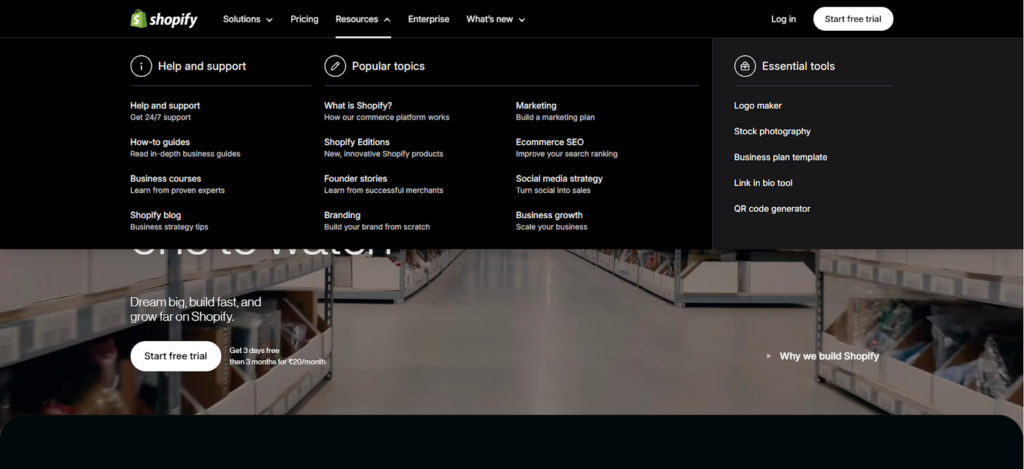
So, when it comes to support, Shopify wins with its 24/7 availability and wide range of help resources, while Etsy’s support can be slower and less accessible when you need immediate assistance.
Which One Is Right For Your Business?
Having examined how these platforms compare across all the critical areas — from setup to scalability — let’s now focus on helping you make the right choice based on your specific business needs and goals.
Now that we have compared Shopify and Etsy across all key areas, the final choice really comes down to your goals, product type, and how much control you want over your business.
Choose Etsy if
You’re just starting, want to test product ideas, or sell handmade, vintage, or craft items without the need to build a website.
Etsy’s built-in audience and simple setup make it a great driving force for creative sellers who prefer ease over customization.
Choose Shopify if
You are ready to build a long-term brand, want full control over your store’s design and customer experience, and aim to scale your business.
Shopify gives you the flexibility, tools, and ownership to grow on your terms, whether you’re selling physical, digital, or even subscription-based products.
Final Thoughts
In summary, your choice between Shopify and Etsy depends on your business goals, the type of handmade products you offer, and whether you want to build a standalone store or leverage an existing online marketplace. Consider your marketing strategies, desired customer base, and monthly costs before making your decision.
Frequently Asked Questions (FAQs)
Have more questions? Here are some common ones that new sellers ask when choosing between Shopify and Etsy.
1. Can I Sell on Etsy and Shopify?
Absolutely! Many successful sellers use both platforms- Etsy for its built-in audience and Shopify for brand building and scalability. This approach lets you test products on Etsy and then expand with your own Shopify store as your business grows.
2. Should I do both Shopify and Etsy at the same time?
Yes, many sellers use both platforms to maximize visibility and sales. You can use Etsy to reach its built-in audience while building your brand on Shopify. Just be careful of managing inventory across both.
3. Is Etsy better than Shopify?
Etsy is easier to start with since it doesn’t require building a website and offers immediate access to a large audience. Shopify has a slight learning curve, but it’s still beginner-friendly and gives you more freedom to grow.
4. Do I need technical skills to use Shopify?
Not at all. Shopify’s drag-and-drop builder and intuitive dashboard make it easy to set up and run your store — no coding required. But if you want advanced customizations, it also allows access to code.
5. Which is cheaper: Shopify or Etsy?
Etsy has lower upfront costs, but the fees can add up as your sales grow. Shopify has a monthly fee, but its flat-rate pricing becomes more cost-effective over time, especially for high-volume sellers.
6. Can I migrate from Etsy to Shopify later?
Yes. Many sellers start on Etsy and move to Shopify once they’re ready to build a branded store. There are tools and apps available to help migrate your product listings and customer data.
7. Do I need a domain name to sell on Shopify or Etsy?
Shopify allows you to use a custom domain, which is great for branding. Etsy doesn’t require a domain — your shop lives within the Etsy marketplace and uses their default URL structure.
8. Which platform is better for building a long-term brand?
Shopify is better suited for building and scaling a long-term brand since you have full control over your store’s look, customer data, and marketing.
9. Shopify or Etsy Reddit: What Does the Community Say?
If you search “Shopify or Etsy Reddit,” you’ll find that many sellers recommend starting on Etsy for quick sales and moving to Shopify for long-term growth. The consensus is that both platforms have pros and cons, and the best approach depends on your goals.
10. Where Should I Sell Online?
Choosing where to sell online depends on your products, goals, and desired level of control. Etsy is best for beginners, artists, and handmade sellers who want instant access to buyers. Shopify is best for those who want to build a brand, scale, and have full control over their store.
Ready to Take the Next Step?
Look, choosing between Shopify and Etsy isn’t just about platforms — it’s about the kind of business you want to build.
If you’re happy keeping things simple and selling the occasional product to a built-in audience, Etsy will do the job. It’s quick, it’s easy, and it’s a solid way to test the waters.
But if you’re serious about growth…
If you want full control over your brand, your customer data, and how your store performs, then Shopify is the platform that sets you up to scale.
That’s why we work exclusively with brands that are ready to take that next step. No fluff. No guesswork. Just strategies that are built to convert and drive revenue.
If you are ready to build a Shopify store that actually performs, or you want to optimize what you already have.
Get in touch with our team. We will map out what’s working, what’s not, and what it’s going to take to hit your next revenue goal.
You’re not just choosing a platform. You are choosing how you grow.
So make it count.
Source: How many people shop online






Post a Comment
Got a question? Have a feedback? Please feel free to leave your ideas, opinions, and questions in the comments section of our post! ❤️